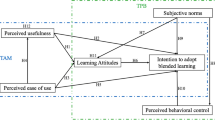Abstract
This paper focuses on the analysis of perceived usefulness (PU), perceived ease-of-use (PE), perceived playfulness (PP), community support (CS), and other factors that affect the acceptance of Chinese students (SA) in Blended learning of primary science curriculum. Based on technology acceptance model and Unified Theory of Acceptance and Use of Technology, an initial structural equation model is proposed. The initial structural model is for blended learning student acceptance (SA) in primary science curriculum. It contains five latent variables, and 4 latent variables can affect SA. Questionnaire responses are collected through blended learning SA questionnaire survey and analyzed using statistical methods. The questionnaire has 25 questions and collects 357 answers from all over China. Based on the reliability analysis, exploratory factor analysis, and confirmatory factor analysis of the data, the initial structural equation model is improved. According to the final structural equation model, the influence order of influencing factors on primary science curriculum blended learning SA is CS > PP > PU > PE. Based on the final model, an interactive visualization application is designed and implemented using SAP Analytics Cloud to allow users to understand the model easily and explore interactions among these factors visually. Teachers can directly see the changes of various factors through visualization, and do not need to pay attention to complex model details. This approach provides new practice for the application of theoretical models in Pedagogy.















Similar content being viewed by others
Data availability
The data that support the findings of this study are openly available in IEEE DataPort at http://doi.org/10.21227/kx61-7732, reference (Xu., 2020).
Abbreviations
- TAM:
-
Technology acceptance model
- UTAUT:
-
Unified Theory of Acceptance and Use of Technology
- PE:
-
Performance expectancy
- EE:
-
Effort expectancy
- SI:
-
Social influence
- FC:
-
Facilitating conditions
- PU:
-
Perceived usefulness
- PE:
-
Perceived ease-of-use
- PP:
-
Perceived playfulness
- CS:
-
Community support
- SA:
-
Student acceptance
- ML:
-
Maximum likelihood
- GLS:
-
Generalized least squares
- KMO:
-
Kaiser–Meyer–Olkin
- SAC:
-
SAP Analytics Cloud
- VR:
-
Virtual reality
References
Alam, M. S. (2015). Effect of community factors on primary school learners’ achievement in rural Bangladesh. Journal of learning for Development. http://hdl.handle.net/11599/870
Al-Azawei, A., Parslow, P., & Lundqvist, K. (2017). Investigating the effect of learning styles in a blended e-learning system: An extension of the technology acceptance model (TAM). Australasian Journal of Educational Technology. https://doi.org/10.14742/ajet.2741
Alshurideh, M., Salloum, S. A., Al Kurdi, B., & Al-Emran, M. (2019). Factors affecting the social networks acceptance: an empirical study using PLS-SEM approach. Paper presented at the Proceedings of the 2019 8th international conference on software and computer applications.
Bateson, P., Bateson, P. P. G., & Martin, P. (2013). Play, playfulness, creativity and innovation. Cambridge University Press.
Bentler, P. M. (1992). On the fit of models to covariances and methodology to the Bulletin. Psychological Bulletin, 112(3), 400–404. https://doi.org/10.1037//0033-2909.112.3.400
Bliuc, A.-M., Casey, G., Bachfischer, A., Goodyear, P., & Ellis, R. A. (2012). Blended learning in vocational education: Teachers’ conceptions of blended learning and their approaches to teaching and design. The Australian Educational Researcher, 39(2), 237–257. https://doi.org/10.1007/s13384-012-0053-0
Chen, W. S., & Yao, A. Y. T. (2016). An empirical evaluation of critical factors influencing learner satisfaction in blended learning: A pilot study. Universal Journal of Educational Research, 4(7), 1667–1671. https://doi.org/10.13189/ujer.2016.040719
Choi, J. J., & Ngo-Ye, T. L. (2019). Selecting enterprise applications for curriculum: Insights from a teaching initiative. Issues in Information Systems, 20(1), 195–203.
Choo, J., & Liu, S. (2018). Visual analytics for explainable deep learning. IEEE Computer Graphics and Applications., 38(4), 84–92. https://doi.org/10.1109/ACCESS.2019.2923736
Davis, F. D. (1989). Perceived usefulness, perceived ease of use, and user acceptance of information technology. Management Information Systems Quarterly, 13(3), 319–340. https://doi.org/10.2307/249008
Donaldson, R. L. (2011). Student acceptance of mobile learning. Dissertations & Theses—Gradworks, 62(12), 4763–4766.
Dwivedi, Y. K., Mustafee, N., Carter, L. D., & Williams, M. D. (2010). A bibliometric comparison of the usage of two theories of IS/IT acceptance (TAM and UTAUT). Paper presented at the AMCIS.
Estriegana, R., Medina-Merodio, J.-A., & Barchino, R. (2019). Student acceptance of virtual laboratory and practical work: An extension of the technology acceptance model. Computers & Education, 135, 1–14.
Grossmann, S. D., Moura, M. D., Matias, M. D., Paiva, S. M., & Mesquita, R. A. (2018). The use of social networks in scientific research with questionnaires. Brazilian Journal of Oral Sciences., 17, e18162.
Huang, J., Lin, Y., & Chuang, S. (2007). Elucidating user behavior of mobile learning—a perspective of the extended technology acceptance model. The Electronic Library, 25(5), 585–598. https://doi.org/10.1108/02640470710829569
Legris, P., Ingham, J., & Collerette, P. (2003). Why do people use information technology? A critical review of the technology acceptance model. Information & Management, 40(3), 191–204. https://doi.org/10.1016/S0378-7206(01)00143-4
Li, C., He, L., & Wong, I. A. (2021). Determinants predicting undergraduates’ intention to adopt e-learning for studying English in Chinese higher education context: A structural equation modelling approach. Education and Information Technologies., 26, 4221–4239.
Lin, C. P., & Anol, B. (2008). Learning online social support: An investigation of network information technology based on UTAUT. Cyberpsychology & Behavior the Impact of the Internet Multimedia & Virtual Reality on Behavior & Society, 11(3), 268–272. https://doi.org/10.1089/cpb.2007.0057
Liu, Q., Yang, H., Ba, S., Wang, Y., & Zhao, W. (2019). Blended learning using mobile APP in secondary vocational instruction: design and implementation. In Proceedings of the 10th international conference on e-education, e-business, e-management and e-learning (pp. 189–193). https://doi.org/10.1145/3306500.3306544
Liu, Y., Li, H., & Carlsson, C. (2010). Factors driving the adoption of m-learning: An empirical study. Computers in Education, 55(3), 1211–1219. https://doi.org/10.1016/j.compedu.2010.05.018
Marchewka, J. T., & Kostiwa, K. (2007). An application of the UTAUT model for understanding student perceptions using course management software. Communications of the IIMA, 7(2), 10.
Means, B., Toyama, Y., Murphy, R., & Baki, M. (2013). The effectiveness of online and blended learning: A meta-analysis of the empirical literature. Teachers College Record, 115(3), 1–47.
Montgomery, A. P., Mousavi, A., Carbonaro, M., Hayward, D. V., & Dunn, W. (2019). Using learning analytics to explore self-regulated learning in flipped blended learning music teacher education. British Journal of Educational Technology, 50(1), 114–127. https://doi.org/10.1111/bjet.12590
Padilla-Meléndez, A., del Aguila-Obra, A. R., & Garrido-Moreno, A. (2013). Perceived playfulness, gender differences and technology acceptance model in a blended learning scenario. Computers & Education, 63, 306–317.
Picciano, A. G., Dziuban, C. D., & Graham, C. R. (2013). Blended learning: Research perspectives (Vol. 2). Routledge.
Pitafi, A. H., Kanwal, S., & Khan, A. N. (2020). Effects of perceived ease of use on SNSs-addiction through psychological dependence, habit: The moderating role of perceived usefulness. International Journal of Business Information Systems., 33(3), 383–407.
Powell, A., Watson, J., Staley, P., Patrick, S., Horn, M., Fetzer, L., …Verma, S. (2015). Blending learning: The evolution of online and face-to-face education from 2008–2015. Promising practices in blended and online learning series. International Association for K-12 Online Learning.
Rabu, S. N., & Talib, Z. (2017). The effects of digital game-based learning on primary school students’ English vocabulary achievement and acceptance. Innovative Teaching and Learning Journal (ITLJ)., 1(1), 61–74.
Sani, A., Khristiana, Y., Zailani, A. U., & Husain, T. (2020). E-business adoption models in organizational contexts on the TAM extended model: A preliminary assessment. In 2020 8th International conference on cyber and IT service management (CITSM), 232020 October (pp. 1–5). IEEE.
Shimizu, S., & Kano, Y. (2008). Use of non-normality in structural equation modeling: Application to direction of causation. Journal of Statistical Planning and Inference, 138(11), 3483–3491. https://doi.org/10.1016/j.jspi.2006.01.017
Thompson, B. (2000). Ten commandments of structural equation modeling. American Psychological Association.
Venkatesh, V., Morris, M. G., Davis, G. B., & Davis, F. D. (2003). User acceptance of information technology: Toward a unified view. MIS Quarterly, 27(3), 425–478. https://doi.org/10.2307/30036540
Walny, J., Frisson, C., West, M., Kosminsky, D., Knudsen, S., Carpendale, S., & Willett, W. (2019). Data changes everything: Challenges and opportunities in data visualization design handoff. IEEE Transactions on Visualization and Computer Graphics., 26(1), 12–22.
Wang, Y., Wu, M., & Wang, H. (2009). Investigating the determinants and age and gender differences in the acceptance of mobile learning. British Journal of Educational Technology, 40(1), 92–118. https://doi.org/10.1111/j.1467-8535.2007.00809.x
Williams, M., Rana, N., Dwivedi, Y., & Lal, B. (2011). Is UTAUT really used or just cited for the sake of it? A systematic review of citations of UTAUT’s originating article. In 19th European conference on information systems, Helsinki, Finland, 9–11 June 2011.
Xinni, J., Zhangyi, W., Dongwei, W., & Yan, L. (2015). Comparison of GLS and WLS method based on measurement model of structural equation modeling. Chinese Journal of Public Health, 31(01), 104–108. (in Chinese).
Xiong, Y., Li, H., Kornhaber, M. L., Suen, H. K., Pursel, B., & Goins, D. D. (2015). Examining the relations among student motivation, engagement, and retention in a MOOC: A structural equation modeling approach. Global Education Review, 2(3), 23–33.
Xu, L. (2018). Exploring MOOC Design for musical instrument education. Digital Education, 4(04), 17–22. https://doi.org/10.3969/j.issn.2096-0069.2018.04.003 (in Chinese).
Xu, L. (2019). User story based information visualization type recommendation system. International Journal of Information Engineering and Electronic Business, 11(3), 1–7. https://doi.org/10.5815/ijieeb.2019.03.01
Xu, L. (2020). Student acceptance of blended learning - primary science curriculum – China. https://ieee-dataport.org/open-access/student-acceptance-blended-learning-primary-science-curriculum-china. https://doi.org/10.21227/kx61-7732
Yongjun, J., & Xin, L. (2020). Characteristics analysis of teachers’ online learning behavior supported by learning analytics. China Educational Technology, 11(2), 75–82. (in Chinese).
Zacharis, N. Z. (2015). A multivariate approach to predicting student outcomes in web-enabled blended learning courses. The Internet and Higher Education, 27, 44–53. https://doi.org/10.1016/j.iheduc.2015.05.002
Zhai, X., & Shi, L. (2020). Understanding how the perceived usefulness of mobile technology impacts physics learning achievement: A pedagogical perspective. Journal of Science Education and Technology., 29(6), 743–757.
Zhang, Z., Cao, T., Shu, J., & Liu, H. (2020). Identifying key factors affecting college students’ adoption of the e-learning system in mandatory blended learning environments. Interactive Learning Environments. https://doi.org/10.1080/10494820.2020.1723113
Acknowledgements
The author would like to thank teachers and students of Institute of Vocational Education, Tongji University, especially Prof. Dr. Yue, CAI for his guidance on educational theory and statistics, and Ms. Gao-Le, LI for her assistance in collecting survey data for this paper.
Author information
Authors and Affiliations
Contributions
The main contribution of the author in the paper is designing one new structural equation modeling for primary science curriculum students and using collected survey data to improve and verify the model. The author also gives one new visual analytics approach to explore the structural model interactively.
Corresponding author
Ethics declarations
Conflict of interest
In accordance with my ethical obligation as a researcher, I am reporting that I have business interests in a company that may be affected by the research reported in the enclosed paper.
Additional information
Publisher's Note
Springer Nature remains neutral with regard to jurisdictional claims in published maps and institutional affiliations.
Rights and permissions
About this article
Cite this article
Liu, X. Primary science curriculum student acceptance of blended learning: structural equation modeling and visual analytics. J. Comput. Educ. 9, 351–377 (2022). https://doi.org/10.1007/s40692-021-00206-8
Received:
Revised:
Accepted:
Published:
Issue Date:
DOI: https://doi.org/10.1007/s40692-021-00206-8




